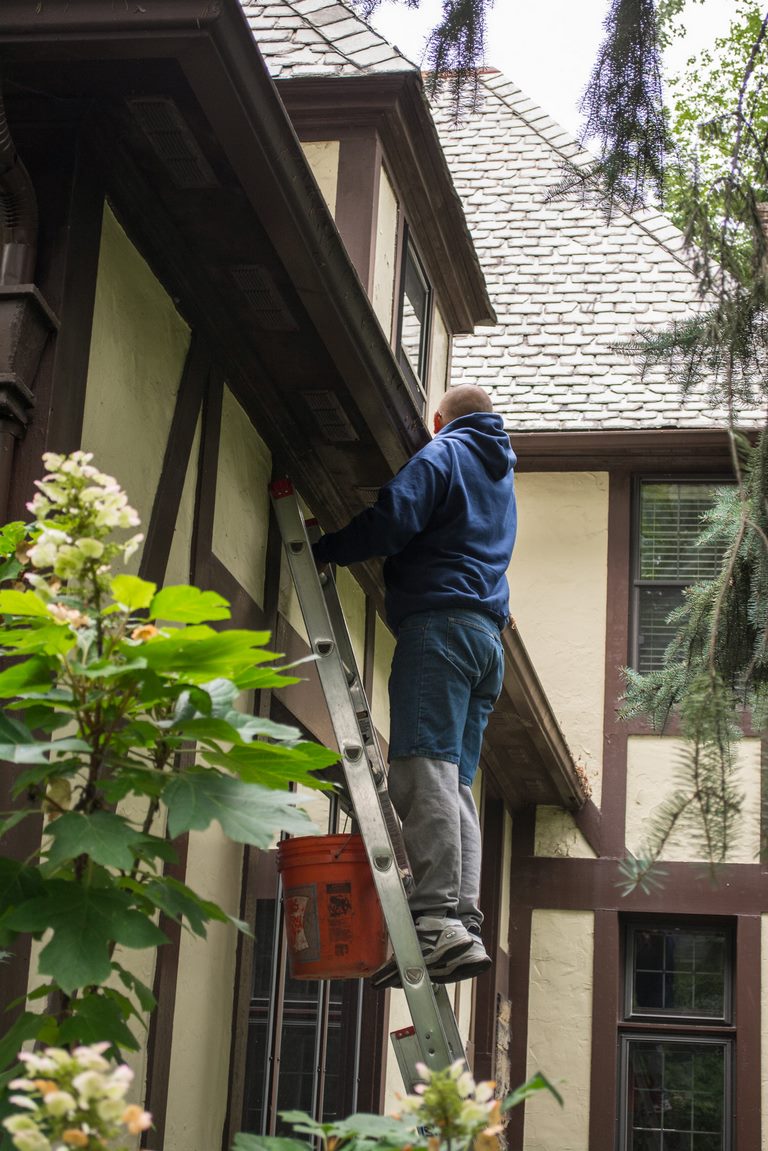Property and timely care of the gutter system significantly increase its service life. Gutter cleaning mainly implies inspection and cleaning of the system.
In the event of a breakdown or untimely cleaning of gutters, water can seep into the most unexpected place and eventually damage the foundation and walls of the house.

To prevent the worst consequences, it is necessary to seriously approach not only the choice of the drain but also its planned prevention.
What is the Most Common Clogging of the Drainage System?
After winter, damage to the gutter can be caused by the formed ice or debris that has accumulated since the fall.
Even a small amount of fall foliage can damage the integrity of the gutter, break it, or lead to leakage.
A blockage can also serve as a source of active propagation of moss and plants through the drainpipe, which will be quite difficult to remove during cleaning.
In the summer, hornets’ nests can form in such blockages, and then you will have to call not only gutter cleaning services but also exterminators.
In order to prevent blockages, you should regularly clean the drain, carry out the treatment of gutters from ice.
Read Also:
Local Gutter Cleaning with the Help of Creative Resources
Choose a suitable ladder first.
Since most gutters are installed under the roof of the house, the staircase must be sufficiently stable. If your house is two or more stories high, it is better to install scaffolding or use climbing equipment or use the services of an aerial platform.
Thoroughly clean all upper pipes and funnels, and place debris in a prepared box or bag.
Clean the pipes from both sides of the build-up sediment using special homemade scrapers and long sticks.
A clogged downpipe can be cleaned with a plumbing cable.
Rinse the gutter with water – from a bucket or hose, after placing an empty bucket or barrel under the drain hole so that all the debris is collected in one place.
Сleaning of the Drainage System Using Compressed Air
You can clean the drain with the help of special equipment – an air blower, which can both suck in air and blow it out with high pressure.
A sufficiently strong airflow can knock all accumulated debris off the roof and pipes and clear blockages, but it may not be enough if the blockage is deep in the pipes.
If you are working at heights, you can use a compact battery-powered air blower, not a gas or electric air blower.
The downside to cleaning the gutter in this way is that the air blower is not cheap.
Cleaning With Water Under Pressure
The third way to clean the drain is to clean the pipes with pressured water.
You can also use a simple garden hose, but as a cleaning method after manual work, since the low pressure will not allow you to remove all blockages entirely.
Use a generator with a special nozzle that creates a high-water pressure. Connect a regular garden hose through it and clean the pipes. If you have plastic pipes installed, this method is unacceptable, because strong pressure can damage the integrity of the pipe.
How to Clean the Gutter from Ice?
Very often, problems with downpipes occur in the spring, when the frost ends. Water cannot pass through frozen pipes and the blockages formed in them. Downpipes become heavier and can collapse under their weight.
The easiest way to clean is to wait until it gets warm. The method is inexpensive, but it can completely destroy the drainage system during prolonged thaw or rains.
Preheat the gutter with a heating cable or heat gun and carry out a quick anti-icing treatment. The method is costly and not always effective.
How to Prevent Blockages in the System and How to Avoid Icing
Do the gutter cleaning in Elgin IL at least twice a year – in spring, at an established above-zero temperature, and in autumn, before the first frost. If your home is close to a forest or a large cluster of trees, do an extra summer cleanup.
Carefully check the tightness of the pipes in the connection areas. Cover the joints with special metal tapes or replace damaged areas.
To prevent leaves, falling fruit, or wind-blown debris from entering the pipe, when installing drainpipes, it is necessary to “cover” them and all installed funnels with a special metal mesh, no more than two by two centimeters in size. Larger holes won’t help keep feathers, dust, and debris out.
The lifespan of drainpipes is different, and sometimes it is not long enough. It is in our power to increase this period – to use only high-quality materials during construction, to properly and systematically gutter cleaning and repair, to remove all blockages and debris in time, to carry out timely processing against ice and rust.









